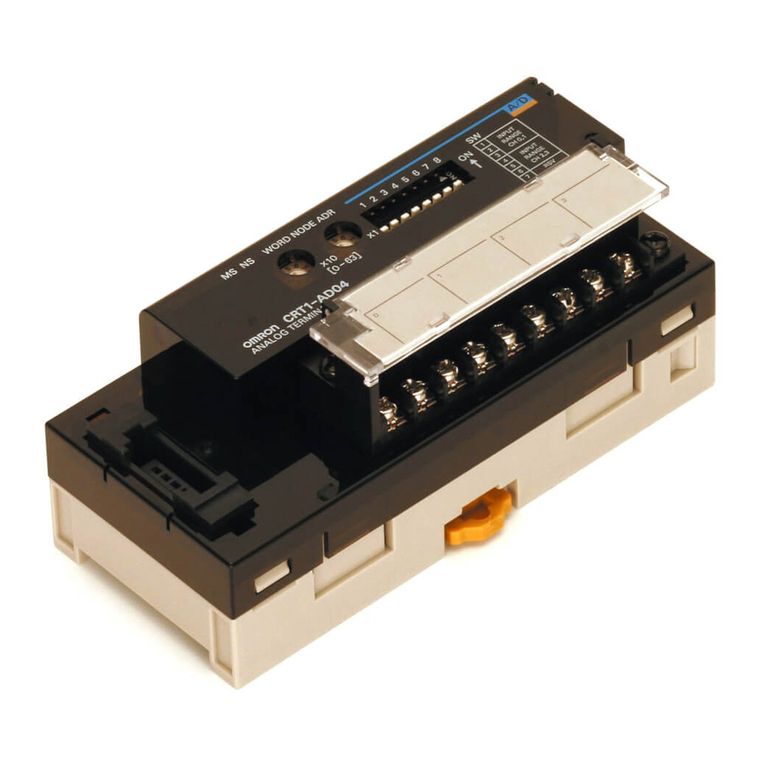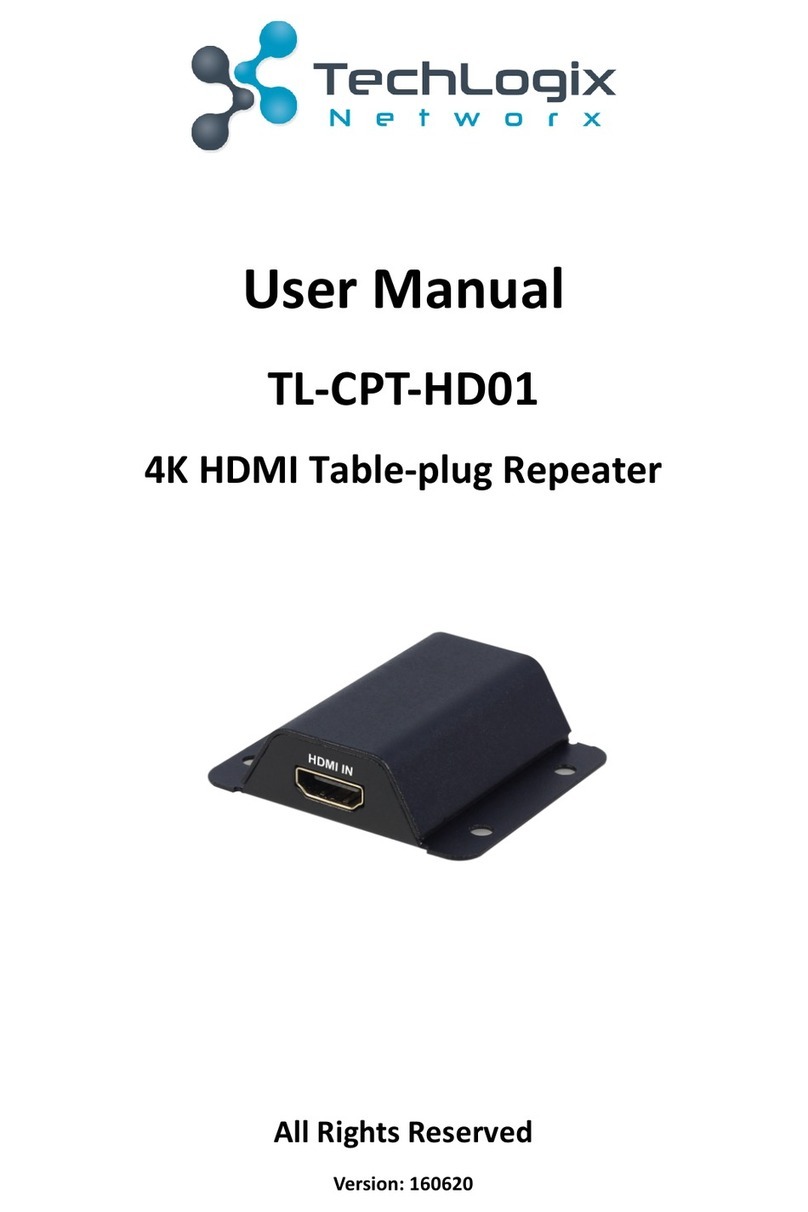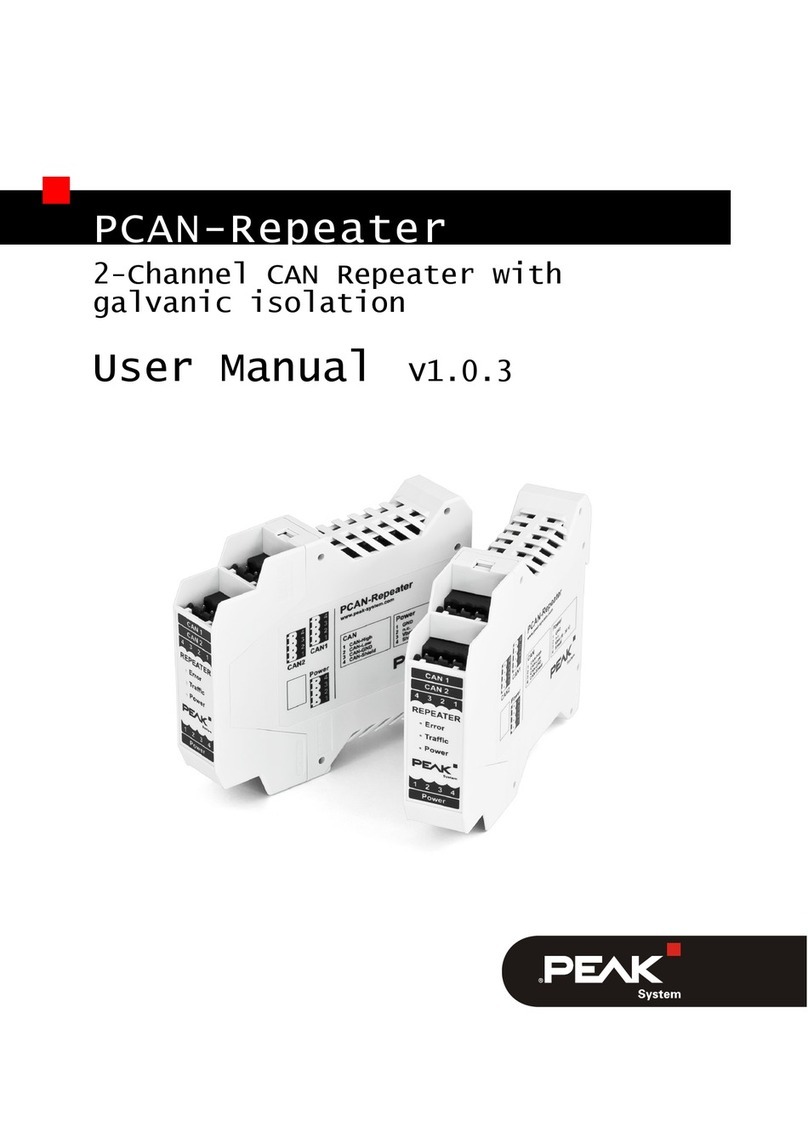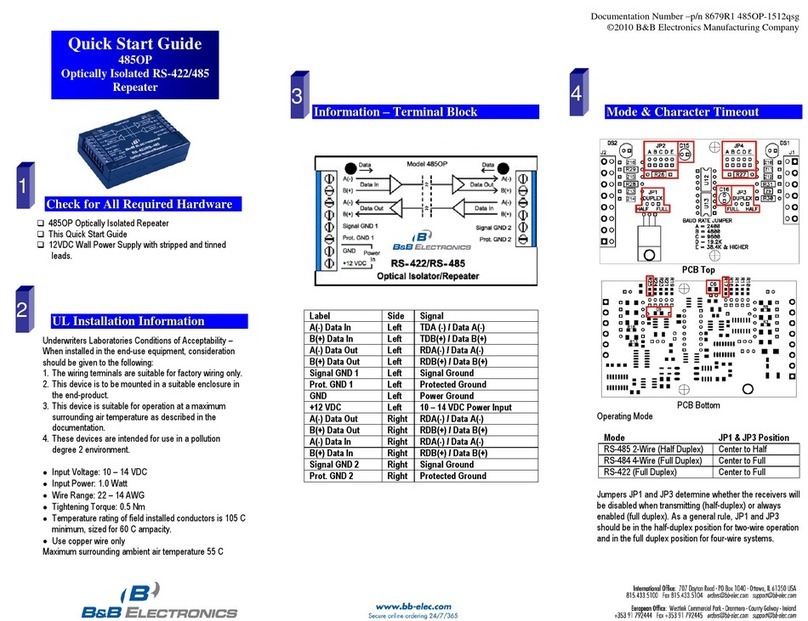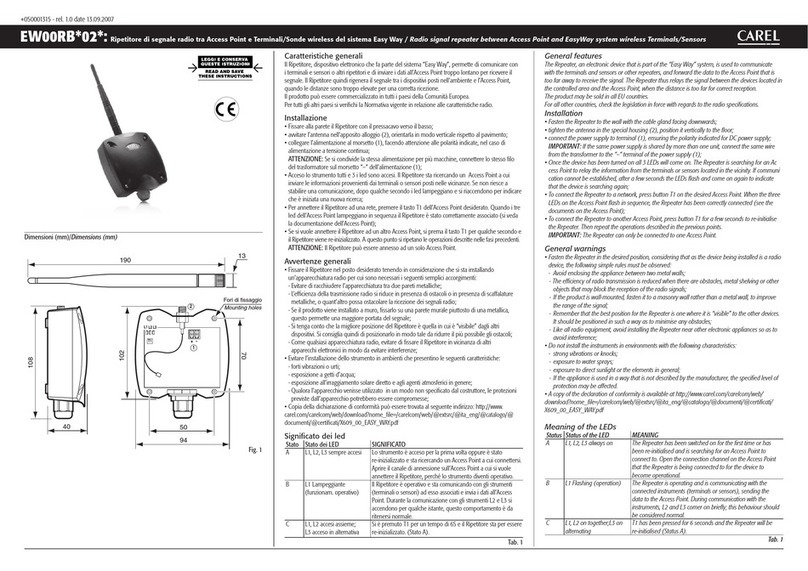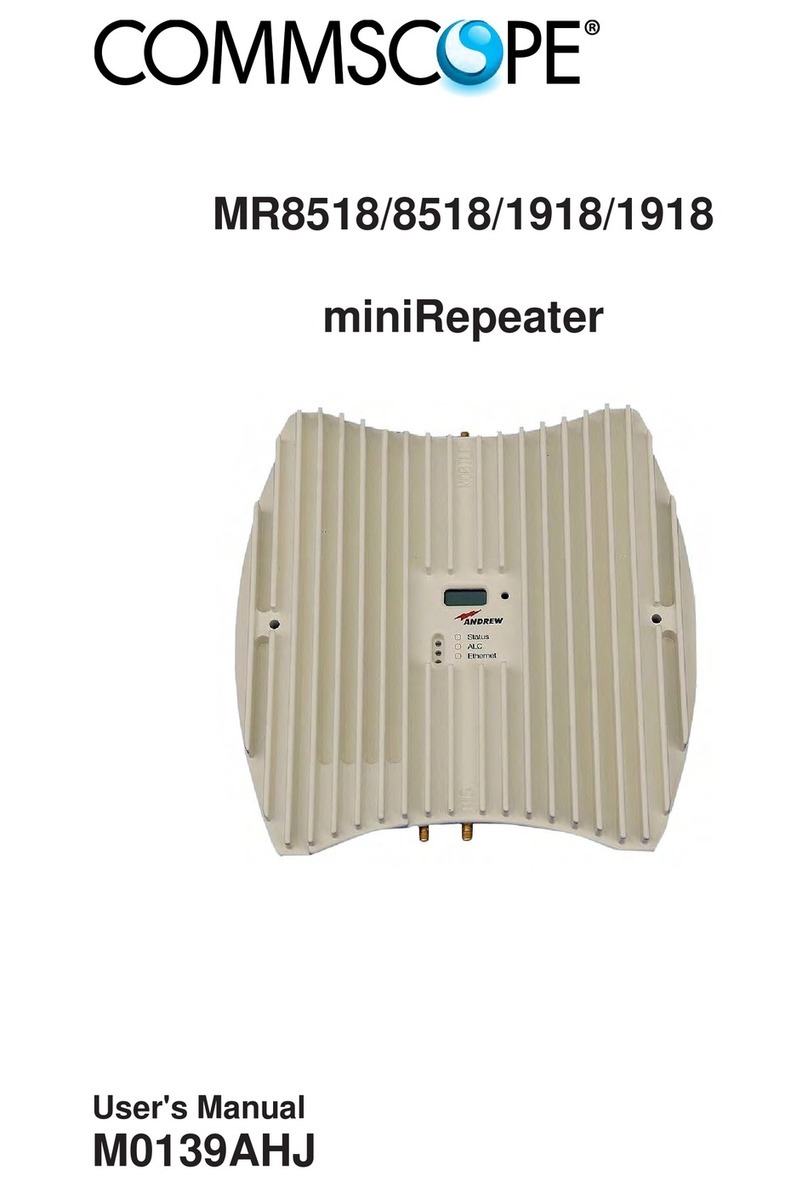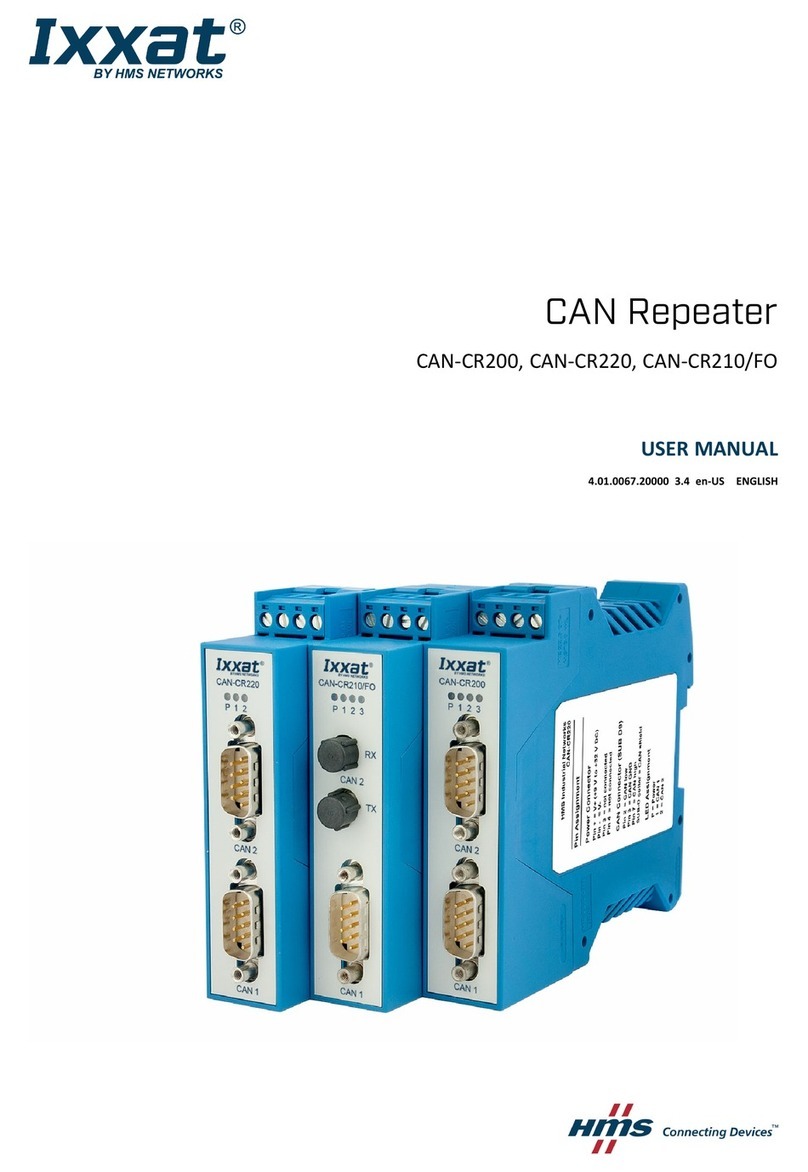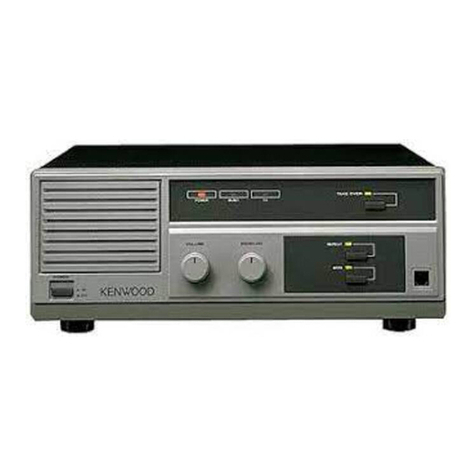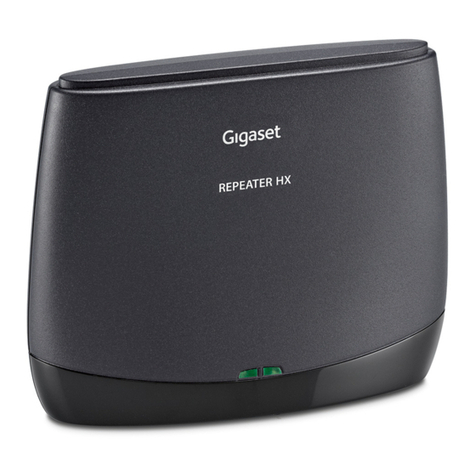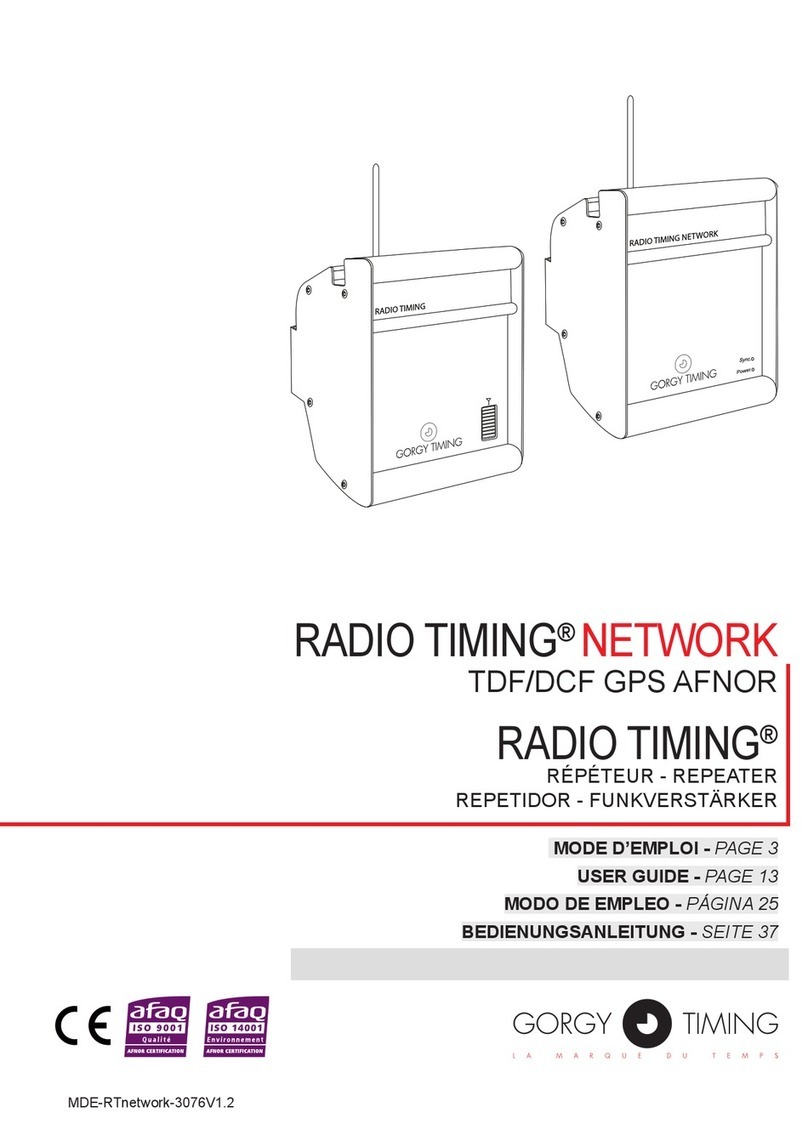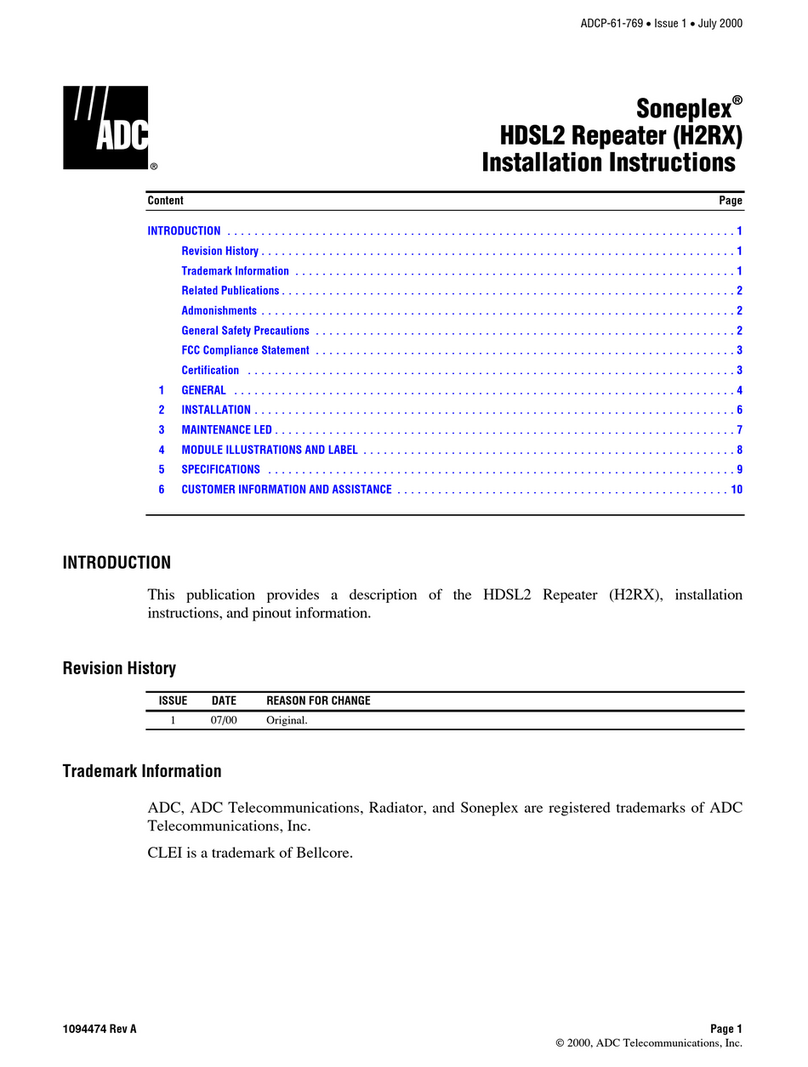GM International D1033D User manual

D1033 - SIL 2 Switch / Proximity Detector Repeater Transistor Output ISM0043-11
D1033D - D1033Q
INSTRUCTION MANUAL
INSTRUCTION MANUAL
SIL 2 Switch/Proximity Detector
Repeater Transistor Output
DIN-Rail Models D1033D, D1033Q

D1033 - SIL 2 Switch / Proximity Detector Repeater Transistor Output G.M. International ISM0043-11
2
General Description: The Switch/Proximity Detector Repeater type D1033 is a DIN Rail unit with two or four independent and isolated channels.
The unit can be configured for contact or proximity detector, NO or NC and for NC or NO optocoupled open collector transistor output. Each channel enables a Safe Area load to be
controlled by a switch, or a proximity detector, located in Hazardous Area.
D1033Q quad channel type has four independent input channels and actuates the corresponding output transistor. Two actuation modes can be independently DIP switch configured
on each input channel: NO input/NC transistor or NO input/NO transistor. Contact or proximity sensor and its connection line short or open circuit fault detection is also DIP switch
configurable: fault detection can be enabled (in case of fault it de-energizes the corresponding output transistor and turns the fault LED on) or disabled (in case of fault the
corresponding output transistor repeats the input line open or closed status as configured).
D1033D dual channel type has two input channels and four output transistors; the unit has two DIP switch configurable operating modes:
Mode A) input channel actuates in parallel the two output transistors. Transistor actuation mode can be independently configured for each output in two modes:
NO input/NC transistor or NO input/NO transistor.
Mode B) input channel actuates output transistor A configurable in two modes as in mode A above. Output transistor B operates as a fault output (in case of input fault, transistor B
actuates and the fault LED turns on while transistor A repeats the input line as configured). Actuation can be DIP switch configured in two modes:
No input fault/energized transistor (it de-energizes in case of fault) or No input fault/de-energized transistor (it energizes in case of fault).
Function: 2 or 4 channels I.S. switch repeater for contact or EN60947-5-6 proximity. Provides 3 port isolation (input/output/supply). Line-fault detection, common to all input signals,
available when using Power Bus enclosure.
Signalling LEDs: Power supply indication (green), output status (yellow), line fault (red).
Field Configurability: NO/NC input for contact/proximitor, NC/NO transistor operation and fault detection enable/disable.
EMC: Fully compliant with CE marking applicable requirements.
Characteristics
Supply: 24 Vdc nom (20 to 30 Vdc) reverse polarity protected, ripple within voltage limits 5 Vpp.
Current consumption @ 24 V: 55 mA for 4 channels D1033Q, 35 mA for 2 channels D1033D with input closed and transistors energized.
Power dissipation: 1.3 W for 4 channels D1033Q, 0.9 W for 2 channels D1033Q with 24 V supply voltage, input closed and transistors energized.
Max. power consumption: at 30 V supply voltage, short circuit input and transistors energized, 1.5 W for 4 channels D1033Q, 1.1 W for 2 channels D1033D.
Isolation (Test Voltage): I.S. In/Out 1.5 KV; I.S. In/Supply 1.5 KV; I.S. In/I.S. In 500 V; Out/Supply 500 V; Out 1-3/Out 2-4 500 V.
Input switching current levels: ON 2.1 mA, OFF 1.2 mA, switch current 1.65 mA ± 0.2 mA hysteresis.
Fault current levels: open fault 0.2 mA, short fault 6.8 mA
(when enabled both faults de-energize channel transistor with quad channel unit D1033Q or actuate fault transistor with dual channel unit D1033D).
Input equivalent source: 8 V 1 Ktypical (8 V no load, 8 mA short circuit).
Output: voltage free SPST optocoupled open-collector transistor.
Open-collector rating: 100 mA at 35 V (2.5 V voltage drop or 1.0 V voltage drop for versions -052 and -058).
Leakage current: 50 µA at 35 V.
Response time: 500 µs.
Frequency response: 2 KHz maximum.
Compatibility:
CE mark compliant, conforms to 94/9/EC Atex Directive and to 2004/108/CE EMC Directive.
Environmental conditions: Operating: temperature limits -20 to + 60 °C, relative humidity max 90 % non condensing, up to 35 °C.
Storage: temperature limits – 45 to + 80 °C.
Safety Description:
II (1) G [Ex ia Ga] IIC, II (1) D [Ex ia Da] IIIC, I (M1) [Ex ia Ma] I, II 3G Ex nA II T4, [Ex ia Ga] IIC, [Ex ia Da] IIIC, [Ex ia Ma] I associated electrical apparatus.
Uo/Voc = 9.6 V, Io/Isc = 10 mA, Po/Po = 24 mW at terminals13-14, 15-16, 9-10, 11-12.
Um = 250 Vrms, -20 °C Ta 60 °C.
Approvals: DMT 01 ATEX E 042 X conforms to EN60079-0, EN60079-11, EN60079-26, EN61241-0, EN61241-11,
IECEx BVS 07.0027X conforms to IEC60079-0, IEC60079-11, IEC60079-26, IEC61241-0, IEC61241-11, IMQ 09 ATEX 013 X conforms to EN60079-0, EN60079-15,
UL & C-UL E222308 conforms to UL913 (Div.1), UL 60079-0 (General, All Zones), UL60079-11 (Intrinsic Safety “i” Zones 0 & 1), UL60079-15 (”n” Zone 2), UL 1604 (Div.2) for UL and
CSA-C22.2 No.157-92 (Div.1), CSA-E60079-0 (General, All Zones), CSA-E60079-11 (Intrinsic Safety “i” Zones 0 & 1), CSA-C22.2 No. 213-M1987 (Div. 2) and
CSA-E60079-15 (”n” Zone 2) for C-UL, refer to control drawing ISM0131 for complete UL and C-UL safety and installation instructions,
FM & FM-C No. 3024643, 3029921C, conforms to Class 3600, 3610, 3611, 3810 and C22.2 No.142, C22.2 No.157, C22.2 No.213, E60079-0, E60079-11, E60079-15,
Russia according to GOST 12.2.007.0-75, R 51330.0-99, R 51330.10-99 [Exia] IIC X, Ukraine according to GOST 12.2.007.0,22782.0,22782.5 Exia IIC X,
EXIDA Report No. GM03/07-24 R001, SIL 2 according to IEC 61508. Please refer to Functional Safety Manual for SIL applications.
DNV and KR Type Approval Certificate for marine applications.
Mounting: T35 DIN Rail according to EN50022.
Weight: about 165 g D1033Q, 140 g D1033D.
Connection: by polarized plug-in disconnect screw terminal blocks to accomodate terminations up to 2.5 mm2.
Location: Safe Area/Non Hazardous Locations or Zone 2, Group IIC T4, Class I, Division 2, Groups A, B, C, D Temperature Code T4 and Class I, Zone 2, Group IIC, IIB, IIA
T4 installation.
Protection class: IP 20.
Dimensions: Width 22.5 mm, Depth 99 mm, Height 114.5 mm.
Technical Data
For Safety Related System and SIL2, SIL3 Applications according IEC61508 & IEC61511 Standards refer to “Functional Safety Manual” document number ISM0071
SIL Applications

D1033 - SIL 2 Switch / Proximity Detector Repeater Transistor OutputG.M. International ISM0043-11 3
Front Panel and Features
Ordering information
Model: D1033
2 channels D
Common negative and positive
4 channels Q
-052
Common negative only
Common positive only
Power Bus enclosure
blank
-058
/B
• SIL 2 according to IEC 61508 for Tproof = 5 / 10 years (10 / 20 % of total SIF).
• PFDavg (1 year) 1.63 E-04, SFF 85.76 %.
• Input from Zone 0 (Zone 20), Division 1, installation in Zone 2, Division 2.
• NO/NC contact/proximity Detector Input.
• Four opto isolated voltage free transistor Output Signals.
• Common negative or positive output both accepted in standard version D1033.
• Transistor Output for fault detection on dual channel version.
• Line fault detection with common signalling available when using Power Bus enclosure.
• Three port isolation, Input/Output/Supply.
• EMC Compatibility to EN61000-6-2, EN61000-6-4.
• In-field programmability by DIP Switch.
• ATEX, IECEx, UL & C-UL, FM & FM-C, Russian and Ukrainian Certifications.
• Type Approval Certificate DNV and KR for marine applications.
• High Reliability, SMD components.
• High Density, four channels per unit.
• Simplified installation using standard DIN Rail and plug-in terminal blocks.
• 250 Vrms (Um) max. voltage allowed to the instruments associated with the barrier.
D1033
1 2 3 4
9 10 11 12
16151413
5 6 7 8
PWR ON
1 2
STATUS/
FAULT
3 4

D1033 - SIL 2 Switch / Proximity Detector Repeater Transistor Output G.M. International ISM0043-11
4
D1033Q
+ Input Ch 3 for Proximity or
Input Ch 3 for Voltage free Contact
Terminal block connections
HAZARDOUS AREA SAFE AREA
- Input Ch 3 for Proximity or
Input Ch 3 for Voltage free Contact
+ Input Ch 4 for Proximity or
Input Ch 4 for Voltage free Contact
- Input Ch 4 for Proximity or
Input Ch 4 for Voltage free Contact
9
10
11
12
Output Ch 1
1
Output Common Ch 1 and Ch 3
2
+ Power Supply 24 Vdc
3
- Power Supply 24 Vdc
4
Output Ch 2
5
Output Common Ch 2 and Ch 4
6
Output Ch 3
7
Output Ch 4
8
D1033D
+ Input Ch 1 for Proximity or
Input Ch 1 for Voltage free Contact
HAZARDOUS AREA SAFE AREA
- Input Ch 1 for Proximity or
Input Ch 1 for Voltage free Contact
13
14
Output Ch 1-A
1
Output Common Ch 1-A and Ch 1-B
2
+ Power Supply 24 Vdc
3
- Power Supply 24 Vdc
4
Output Ch 2-A
5
Output Common Ch 2-A and Ch 2-B
6
Output Ch 1-B
7
Output Ch 2-B
8
+ Input Ch 1 for Proximity or
Input Ch 1 for Voltage free Contact
- Input Ch 1 for Proximity or
Input Ch 1 for Voltage free Contact
+ Input Ch 2 for Proximity
Input Ch 2 for Voltage free Contact
- Input Ch 2 for Proximity
Input Ch 2 for Voltage free Contact
13
14
15
16
+ Input Ch 2 for Proximity or
Input Ch 2 for Voltage free Contact
- Input Ch 2 for Proximity or
Input Ch 2 for Voltage free Contact
15
16

D1033 - SIL 2 Switch / Proximity Detector Repeater Transistor OutputG.M. International ISM0043-11 5
Parameters Table
In the system safety analysis, always check the Hazardous Area/Hazardous Locations devices to conform with the related system documentation, if the device is Intrinsically Safe check
its suitability for the Hazardous Area/Hazardous Locations and gas group encountered and that its maximum allowable voltage, current, power (Ui/Vmax, Ii/Imax, Pi/Pi) are not exceeded
by the safety parameters (Uo/Voc, Io/Isc, Po/Po) of the D1033 series Associated Apparatus connected to it. Also consider the maximum operating temperature of the field device, check
that added connecting cable and field device capacitance and inductance do not exceed the limits (Co/Ca, Lo/La, Lo/Ro) given in the Associated Apparatus parameters for the effective
gas group. See parameters on enclosure side and the ones indicated in the table below:
Must
be
Hazardous Area/
Hazardous Locations
Device Parameters
D1033 Associated
Apparatus Parameters
Uo / Voc = 9.6 V Ui / Vmax
D1033 Terminals
Ch1
Ch2
13 -14
15 -16
Ch3
Ch4
9 - 10
11 - 12
Io / Isc = 10 mA li / Imax
Ch1
Ch2
13 -14
15 -16
Ch3
Ch4
9 - 10
11 - 12
Po / Po = 24 mW Pi / Pi
Ch1
Ch2
13 -14
15 -16
Ch3
Ch4
9 - 10
11 - 12
Must
be
Hazardous Area/
Hazardous Locations
Device + Cable Parameters
D1033 Terminals D1033 Associated
Apparatus Parameters
(IIC-A, B)
Co / Ca = 3.599 µF
Co / Ca = 209.999 µF
(IIB-C)
(IIA-D)
Ci / Ci device + C cable
Ch1
Ch2
13 -14
15 -16
Ch3
Ch4
9 - 10
11 - 12
Li / Li device + L cable
Ch1
Ch2
13 -14
15 -16
Ch3
Ch4
9 - 10
11 - 12
Li / Ri device and
L cable / R cable
Ch1
Ch2
13 -14
15 -16
Ch3
Ch4
9 - 10
11 - 12
Co / Ca = 25.999 µF
(IIC-A,
B)
Lo / La = 379 mH
Lo / La = 3035 mH
(IIB-C)
(IIA-D)
Lo / La = 1517 mH
(IIC-A, B)
Lo / Ro = 1530 µH/
Lo / Ro = 12310 µH/
(IIB-C)
(IIA-D)
Lo / Ro = 6150 µH/
For installations in which both the Ci and Li of the Intrinsically Safe apparatus exceed 1 % of the Co and Lo parameters of the Associated Apparatus (excluding the cable),
then 50 % of Co and Lo parameters are applicable and shall not be exceeded (50 % of the Co and Lo become the limits which must include the cable such that
Ci device + C cable 50 % of Co and Li device + L cable 50 % of Lo).
If the cable parameters are unknown, the following value may be used: Capacitance 60pF per foot (180pF per meter), Inductance 0.20µH per foot (0.60µH per meter).
The Intrinsic Safety Entity Concept allows the interconnection of Intrinsically Safe devices approved with entity parameters not specifically examined in combination as a system when
the above conditions are respected.
For Division 1 and Zone 0 installations, the configuration of Intrinsically Safe Equipment must be FM approved under Entity Concept (or third party approved);
for Division 2 installations, the configuration of Intrinsically Safe Equipment must be FM approved under non-incendive field wiring or Entity Concept (or third party approved).
NOTE for USA and Canada:
IIC equal to Gas Groups A, B, C, D, E, F and G,
IIB equal to Gas Groups C, D, E, F and G,
IIA equal to Gas Groups D, E, F and G

D1033 - SIL 2 Switch / Proximity Detector Repeater Transistor Output G.M. International ISM0043-11
6
Function Diagram
HAZARDOUS AREA ZONE 0 (ZONE 20) GROUP IIC,
HAZARDOUS LOCATIONS CLASS I, DIVISION 1, GROUPS A, B, C, D,
CLASS II, DIVISION 1, GROUPS E, F, G, CLASS III, DIVISION 1,
CLASS I, ZONE 0, GROUP IIC
SAFE AREA, ZONE 2 GROUP IIC T4,
NON HAZARDOUS LOCATIONS, CLASS I, DIVISION 2,
GROUPS A, B, C, D T-Code T4, CLASS I, ZONE 2, GROUP IIC T4
MODEL D1033Q
13
14
3 +
4 -
1
2 Common Channels 1-3
Supply 24 Vdc
Out 1
5
6 Common Channels 2-4
Out 2
7Out 3
8Out 4
15
16
9
10
11
12
2 Common Channels 1-3
6 Common Channels 2-4
+
-
In 1
Proximity
+
-
In 2
+
-
In 3
+
-
In 4
=
=
=
=
=
=
=
=
=
=
voltage free
Contact
MODEL D1033D
13
14
3 +
4 -
1
2 Common Channel 1
Supply 24 Vdc
Out 1-A
5
6 Common Channel 2
Out 2-A
7Out 1-B
8Out 2-B
15
16
2 Common Channel 1
6 Common Channel 2
+
-
In 1
Proximity
+
-
In 2
=
=
=
=
=
=
voltage free
Contact

D1033 - SIL 2 Switch / Proximity Detector Repeater Transistor OutputG.M. International ISM0043-11 7
D1033 series are isolated Intrinsically Safe Associated Apparatus installed into standard EN50022 T35 DIN Rail located in Safe Area/Non Hazardous Locations or Zone 2, Group IIC,
Temperature Classification T4, Class I, Division 2, Groups A, B, C, D, Temperature Code T4 and Class I, Zone 2, Group IIC, IIB, IIA Temperature Code T4 Hazardous Area/Hazardous
Locations (according to EN/IEC60079-15, FM Class No. 3611, CSA-C22.2 No. 213-M1987, CSA-E60079-15) within the specified operating temperature limits Tamb -20 to +60 °C,
and connected to equipment with a maximum limit for AC power supply Um of 250 Vrms.
Non-incendive field wiring is not recognized by the Canadian Electrical Code, installation is permitted in the US only.
For installation of the unit in a Class I, Division 2 or Class I, Zone 2 location, the wiring between the control equipment and the D1033 associated apparatus shall be accomplished
via conduit connections or another acceptable Division 2, Zone 2 wiring method according to the NEC and the CEC.
Not to be connected to control equipment that uses or generates more than 250 Vrms or Vdc with respect to earth ground.
D1033 series must be installed, operated and maintained only by qualified personnel, in accordance to the relevant national/international installation standards
(e.g. IEC/EN60079-14 Electrical apparatus for explosive gas atmospheres - Part 14: Electrical installations in hazardous areas (other than mines), BS 5345 Pt4, VDE 165,
ANSI/ISA RP12.06.01 Installation of Intrinsically Safe System for Hazardous (Classified) Locations, National Electrical Code NEC ANSI/NFPA 70 Section 504 and 505,
Canadian Electrical Code CEC) following the established installation rules, particular care shall be given to segregation and clear identification of I.S. conductors from non I.S. ones.
De-energize power source (turn off power supply voltage) before plug or unplug the terminal blocks when installed in Hazardous Area/Hazardous Locations or
unless area is known to be nonhazardous.
Warning: substitution of components may impair Intrinsic Safety and suitability for Division 2, Zone 2.
Explosion Hazard: to prevent ignition of flammable or combustible atmospheres, disconnect power before servicing or unless area is known to be nonhazardous.
Failure to properly installation or use of the equipment may risk to damage the unit or severe personal injury.
The unit cannot be repaired by the end user and must be returned to the manufacturer or his authorized representative. Any unauthorized modification must be avoided.
Warning
Operation
D1033 accepts as an input from Hazardous Area/Hazardous Locations a proximity sensor or voltage free electrical contact and repeats their status to Safe Area/Non Hazardous
Locations by optoisolated open collector transistor. Presence of supply power and status of output (energized or de-energized), as well as integrity or fault condition of sensor and
connecting line are displayed by signaling LEDs (green for power, yellow for status and red for fault condition). D1033Q (quad channel type) has four independent isolated input channels
and actuates the corresponding output transistor; two actuation modes can be independently DIP switch configured for each input channel:
Normally open input / Normally close transistor or Normally close input / Normally close transistor
Contact or proximity sensor and its connection line short or open circuit fault detection is also DIP switch configurable. Fault detection can be enabled (in case of fault de-energizes the
corresponding output channel transistor (open) and turns ON the fault LED) or be disabled (in case of fault the corresponding output channel transistor repeats the input line open or
close status as configured). D1033D (dual channel type) has two isolated input channel and four output transistors; the unit has two DIP switch configurable operating modes:
A) Input channel actuates in parallel output transistors (providing a DPST type of output). Transistors actuation can be independently configured for each output in two modes:
Normally open input / Normally close transistor or Normally close input / Normally close transistor
B) Input channel actuates output transistor (A) configurable in two modes as above. Output transistor B operates as fault output (in case of input fault, transistor B actuates and the
fault LED turns on while transistor A repeats the input line as configured). Actuation can be configured in two modes:
No input fault / Close transistor (it de-energizes in case of fault) or No input fault / Open transistor (it energizes in case of fault).
Note: use of voltage free electrical contacts with fault detection enabled requires, near the switch at the end of the line, a 1 Kseries connected resistor and a 10 Kparallel connected
resistor in order to allow the fault detection circuit to distinguish between a condition of contact close/ open and a line open/short circuit fault.
D1033 Associated Apparatus
FM Approved
under Entity Concept
and non-incendive field wiring
Unclassified Locations or
Hazardous (Classified) Locations
Class I, Division 2, Groups A, B, C, D, T-Code T4
Class I, Zone 2, Group IIC, IIB, IIA, T-Code T4
FM Approved under Entity Concept,
or third party approval
Hazardous (Classified) Locations
Class I, Division 1, Groups A, B, C, D
Class II, Division 1, Groups E, F, G
Class III, Division 1
Class I, Zone 0, Group IIC, IIB, IIA
Intrinsically
Safe Equipment
Must not use or generate
more than 250 Vrms or Vdc
Control
Equipment
Unclassified Locations
Hazardous (Classified) Locations
Class I, Division 2, Groups A, B, C, D
Class II, Division 2, Groups E, F, G
Class III, Division 2
Class I, Zone 2, Group IIC, IIB, IIA
FM Approved under non-incendive field
wiring (permitted only for US installations),
or third party approval
13
14
1
2
+
-
-
+
Power Supply
3
4
16
15
-
+
Intrinsically
Safe Equipment
Unclassified Locations or
Hazardous (Classified) Locations
Class I, Division 2, Groups A, B, C, D, T-Code T4
Class I, Zone 2, Group IIC, IIB, IIA, T-Code T4
Unclassified Locations
Must not use or generate
more than 250 Vrms or Vdc
6
5Control
Equipment
Control
Equipment
Control
Equipment
2
6
8
7
Intrinsically
Safe Equipment -
+
10
9
Intrinsically
Safe Equipment
+
-
11
12
+
-Power Supply
Control
Equipment
Control
Equipment
Control
Equipment
Control
Equipment
14
9
11
12
10
16
15
13
4
3
2
7
8
6
2
6
5
1+
-
+
+
-
-
-
+
Non-incendive
Equipment
Non-incendive
Equipment
Non-incendive
Equipment
Non-incendive
Equipment
D1033 Associated Apparatus
FM Approved
under Entity Concept
and non-incendive field wiring

D1033 - SIL 2 Switch / Proximity Detector Repeater Transistor Output G.M. International ISM0043-11
8
Start-up
Before powering the unit check that all wires are properly connected, particularly supply conductors and their polarity, input and output wires, also check that Intrinsically Safe conductors
and cable trays are segregated (no direct contacts with other non I.S. conductors) and identified either by color coding, preferably blue, or by marking. Check conductors for exposed
wires that could touch each other causing dangerous unwanted shorts. Turn on power, the “power on” green led must be lit, status and fault led on each channel must be in accordance
with condition of the corresponding input line. If possible close and open input lines one at time checking the corresponding status and fault leds condition as well as output to be correct.
Installation
D1033 series are switch/proximity detector repeaters housed in a plastic enclosure suitable for installation on T35 DIN Rail according to EN50022.
D1033 unit can be mounted with any orientation over the entire ambient temperature range, see section “Installation in Cabinet” and "Installation of Electronic Equipments in Cabinet"
Instruction Manual D1000 series for detailed instructions.
Electrical connection of conductors up to 2.5 mm² are accommodated by polarized plug-in removable screw terminal blocks which can be plugged in/out into a powered unit
without suffering or causing any damage (for Zone 2 or Division 2 installations check the area to be nonhazardous before servicing).
The wiring cables have to be proportionate in base to the current and the length of the cable.
On the section “Function Diagram” and enclosure side a block diagram identifies all connections and configuration DIP switches.
Identify the number of channels of the specific card (e.g. D1033D is a dual channel model and D1033Q is a quad channel model), the function and location of each connection terminal
using the wiring diagram on the corresponding section, as an example:
Connect 24 Vdc power supply positive at terminal “3” and negative at terminal “4”.
For Model D1033Q connect common output of channel 1-3 at terminal “2” and transistor output at terminal “1” for channel 1 and “7” for channel 3.
For Model D1033Q connect common output of channel 2-4 at terminal “6” and transistor output at terminal “5” for channel 2 and “8” for channel 4.
For Model D1033D connect proximity sensor or voltage free contact at terminal “13” positive and “14” negative for channel 1, connect at terminal “15” and “16” respectively for channel 2.
For Model D1033Q in addition to channel 1-2 connections above, connect terminal “9” positive and “10” negative for channel 3 and “11” positive and “12” negative for channel 4.
Intrinsically Safe conductors must be identified and segregated from non I.S. and wired in accordance to the relevant national/international installation standards
(e.g. EN/IEC60079-14 Electrical apparatus for explosive gas atmospheres - Part 14: Electrical installations in hazardous areas (other than mines), BS 5345 Pt4, VDE 165,
ANSI/ISA RP12.06.01 Installation of Intrinsically Safe System for Hazardous (Classified) Locations, National Electrical Code NEC ANSI/NFPA 70 Section 504 and 505,
Canadian Electrical Code CEC), make sure that conductors are well isolated from each other and do not produce any unintentional connection.
Connect SPST output transistors checking the load rating to be within the maximum rating (100 mA, 35 V resistive load).
The enclosure provides, according to EN60529, an IP20 minimum degree of mechanical protection (or similar to NEMA Standard 250 type 1) for indoor installation, outdoor installation
requires an additional enclosure with higher degree of protection (i.e. IP54 to IP65 or NEMA type 12-13) consistent with the effective operating environment of the specific installation.
Units must be protected against dirt, dust, extreme mechanical (e.g. vibration, impact and shock) and thermal stress, and casual contacts.
If enclosure needs to be cleaned use only a cloth lightly moistened by a mixture of detergent in water.
Electrostatic Hazard: to avoid electrostatic hazard, the enclosure of D1033 must be cleaned only with a damp or antistatic cloth.
Any penetration of cleaning liquid must be avoided to prevent damage to the unit. Any unauthorized card modification must be avoided.
According to EN61010, D1033 series must be connected to SELV or SELV-E supplies.
Power Dissipation of D1033 Isolators
Section “Technical Data” of D1033 isolator specifies the current consumption (maximum current from the nominal power supply, typical 24 Vdc, in normal operation); this data serves to
dimension the current rating of the power supply unit. Section “Technical Data” indicates also the maximumù power consumption (maximum power required from the power supply in the
worst (abnormal) operating conditions like for example supply voltage at 30 Vdc, short circuit on the outputs and on the inputs terminals.
The power dissipated Pd inside the enclosure for analog signal isolators is: Pd = Current Consumption (A) * Supply Voltage (V) - Power Dissipated into the input/output loads
Digital signal isolators have lower dissipation than analog signal isolators, in addition 4 channels barriers (D1033Q) have higher dissipation than single channel units (D1033D).
Isolators are not running at the maximum current all at the same time, the average power consumption of a multitude of isolators can be considered to be only 70 % of the value obtained
from the section “Technical Data”. Considering the 1/3 load power and the 70 % above discussed, the power effectively dissipated internally by the isolators can therefore become ½ of
the actual power delivered by the power supply. Digital barriers dissipate all the supply power inside the enclosure consequently the total power dissipation into a cabinet, with mixed
analog and digital barriers, is determined by the number of channels more than by the number of isolator enclosures. The following tables give advises for the DIN rail orientation
(vertical or horizontal) of the barriers mounting, D1033Q (quadruple channel) and D1033D (double channel) isolators, installed on DIN rail, bus or custom board assembly.
A) Cabinet with Natural Ventilation
Maximum recommended ambient temperature in °C depending on barrier type and installation method:
Installation in Cabinet
Any orientation Vertical Horizontal
Installation of Multiple units with DIN-rail BusSingle unit Installation
Type of Isolator
Vertical Horizontal
Installation on Custom Boards
Any orientation Vertical Horizontal
Installation of Multiple units with DIN-rail BusSingle unit Installation
Type of Isolator
60°C 40°C 45°C
Vertical Horizontal
Installation on Custom Boards
45°C 50°C
D1033D
60°C Not recommended (1) 30°C
D1033D
60°C Not recommended (1) 30°C
D1033Q
30°C 35°C
30°C 35°C
(1) Installation is not recommended since it would significantly shorten the units life and increase the probability of failures.
60°C 40°C 45°C 45°C 50°CD1033Q
B) Cabinet with Forced Ventilation
Maximum recommended ambient temperature in °C depending on barrier type and installation method:

D1033 - SIL 2 Switch / Proximity Detector Repeater Transistor OutputG.M. International ISM0043-11 9
A configuration DIP Switch is located on component side of pcb. This switch allows the configuration of input/output relationship, fault detection functions and operating mode.
Configuration
1234
CH1
5678
CH2 CH3 CH4
ON
Dip switch configuration
D1033Q
1
CH1
Setting
Line fault
detection
ON
IN / OUT
Operation
1
OFF
4
4
3
3
Disabled
(contact / proximity sensor)
Enabled
(proximity sensor or contact
with terminating line resistor)
ON
CH2
Setting
Line fault
detection
ON
IN / OUT
Operation
NO-NC or
NC-NO
NO-NO or
NC-NC ON
OFF
Disabled
(contact / proximity sensor)
Enabled
(proximity sensor or contact
with terminating line resistor)
OFF
Side B Panel View
Input Output Input Output
OutputInputOutputInput
15
NO
16
OR
NC 15
16
15
NO
16
OR
NC 15
16
5
NO
6
NC 5
6
5
NO
6
NC 5
6
NO-NC or
NC-NO
NO-NO or
NC-NC
2
OFF
2ON
Input Output Input Output
OutputInputOutputInput
13
NO
14
OR
NC 13
14
13
NO
14
OR
NC 13
14
1
NO
2
NC 1
2
1
NO
2
NC 1
2

D1033 - SIL 2 Switch / Proximity Detector Repeater Transistor Output G.M. International ISM0043-11
10
8
8
7
7
6
6
5
5
CH3
Setting
Line fault
detection
ON
IN / OUT
Operation
NO-NC or
NC-NO
NO-NO or
NC-NC ON
OFF
Disabled
(contact / proximity sensor)
Enabled
(proximity sensor or contact
with terminating line resistor)
OFF
CH4
Setting
Line fault
detection
ON
IN / OUT
Operation
NO-NC or
NC-NO
NO-NO or
NC-NC ON
OFF
Disabled
(contact / proximity sensor)
Enabled
(proximity sensor or contact
with terminating line resistor)
OFF
Input Output Input Output
OutputInputOutputInput
9
NO
10
OR
NC 9
10
9
NO
10
OR
NC 9
10
7
NO
2
NC 7
2
7
NO
2
NC 7
2
Input Output Input Output
OutputInputOutputInput
11
NO
12
OR
NC 11
12
11
NO
12
OR
NC 11
12
8
NO
6
NC 8
6
8
NO
6
NC 8
6
D1033Q Configuration Summary Table
Channel
IN/OUT Operation
NO-NC or NC-NO
NO-NO or NC-NC
SW1-2
OFF
SW1-4
OFF
ON
1 2 Channel
Line fault detection
Disabled
(contact/proximity sensor)
Enabled
(proximity sensor or contact with terminating line resistor)
SW1-1 SW1-3
1 2
ON
OFF OFF
ONON
SW1-5 SW1-7
3 4
OFF OFF
ONON
SW1-6
OFF
SW1-8
OFF
ON
3 4
ON

D1033 - SIL 2 Switch / Proximity Detector Repeater Transistor OutputG.M. International ISM0043-11 11
6ON
2
1
2
1
5
Switch 8 positions
2
6
2
CH1
Setting
Line fault
detection Disabled
Enabled De-energize
Channel Output
(only A Output section)
B Output
Operation
Normal
(Duplicator)
NO-NC or
NC-NO Mode
IN / OUT
Operation
1
OFF 5OFF
Enabled Fault Output
(only B Output section)
Switch 8 positions
ON 5OFF
Switch 8 positions
1
OFF ON
Ch1-A
Ch1-B ON
OFF
NO-NO or
NC-NC Mode
Switch
8 positions
Fault
Output
1OFF
ON
OFF
ON
OFF
Side B Panel View
ON
ON
NO-NC or
NC-NO
NO-NO or
NC-NC
Input Output Input Output
OutputInputOutputInput
13
NO
14
OR
NC 13
14
13
NO
14
OR
NC 13
14
1
ND
2
NE 1
2
1
ND
2
NE 1
2
ND Mode
NC Mode
No Fault
No Fault
7
ND
2
NC 7
2
Switch
4 positions Input Output Input Output
13
NO
14
NC 13
14
7
NC
2
NO 7
2
Switch
8 positions
Input Output Input Output
13
NO
14
OR
NC 13
14
7
NO
2
NC 7
2
6ON
6
Switch
8 positions
OFF
Switch
8 positions
OR
1234
CH1
56781234
ON
CH1-A CH1-BCH1-B
CH2
CH2-BCH2-B CH2-A
ON
Dip switch configuration
D1033D
Configuration
Switch
4 positions
Switch
8 positions
Switch
8 positions

D1033 - SIL 2 Switch / Proximity Detector Repeater Transistor Output G.M. International ISM0043-11
12
3
7
8
8
8
8
4
37
3
3
7
4
4
3
4
ON
Switch 8 positions
CH2
Setting
Line fault
detection Disabled
Enabled De-energize
Channel Output
(only A Output section)
B Output
Operation
Normal
(Duplicator)
NO-NC or
NC-NO Mode
IN / OUT
Operation
OFF OFF
Enabled Fault Output
(only B Output section)
Switch 8 positions
ON OFF
Switch 8 positions
OFF ON
Ch2-A
Ch2-B ON
OFF
NO-NO or
NC-NC Mode
Switch
8 positions
Fault
Output
OFF
ON
OFF
ON
OFF
NO-NC or
NC-NO
NO-NO or
NC-NC
Input Output Input Output
OutputInputOutputInput
15
NO
16
OR
NC 15
16
15
NO
16
OR
NC 15
16
5
NO
6
NC 5
6
5
NO
6
NC 5
6
NO Mode
NC Mode
No Fault
No Fault
8
NO
6
NC 8
6
Switch
4 positions Input Output Input Output
15
NO
16
NC 15
16
8
NC
6
NO 8
6
Switch
8 positions
Input Output Input Output
15
NO
16
OR
NC 15
16
8
NO
6
NC 8
6
ON
Switch
8 positions
OFF
Switch
8 positions
OR
Switch
4 positions
Switch
8 positions
Switch
8 positions
D1033D Configuration Summary Table
Channel 1A
OFF
ON
Channel 1B
ON
OFF
Mode
NO-NC or NC-NO
NO-NO or NC-NC
NO
NC
1B
OFF
ON
OFF
ON
2A
OFF
ON
IN/OUT Operation SW1-2 B Output Operation SW2-1 SW1-6
SW1-4
NO-NC or NC-NO
NO-NO or NC-NC
2B
OFF
ON
OFF
ON
SW1-8
OFF
ON
SW2-2
Normal (Duplicator)
Fault Output
Channel 1
Line fault detection SW1-1 SW1-5
2
SW1-3 SW1-7
Disabled OFF OFF OFF OFF
Enabled De-energize Channel Output (only A Output section) ON OFF ON OFF
Enabled Fault Output (only B Output section) OFF ON OFF ON
2B
ON
OFF
SW2-3
OFF
ON
SW2-4
This manual suits for next models
1
Table of contents
Other GM International Repeater manuals






